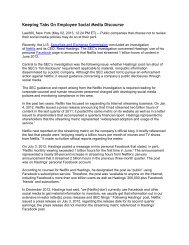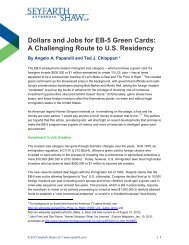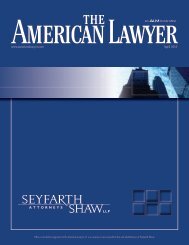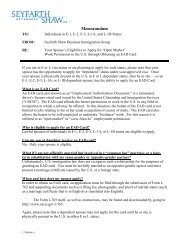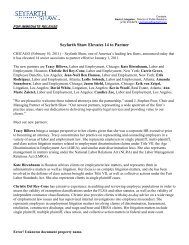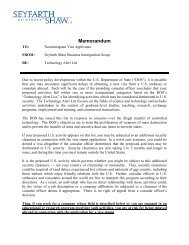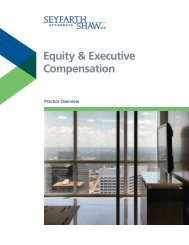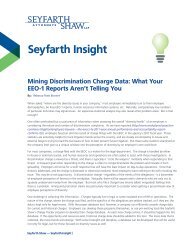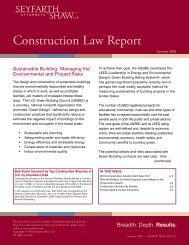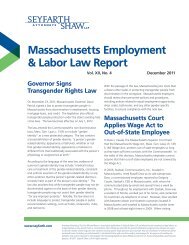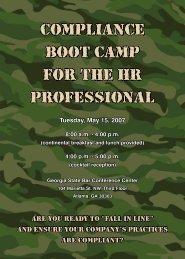Litigating California Wage & Hour and Labor Code Class Actions
Litigating California Wage & Hour and Labor Code Class Actions
Litigating California Wage & Hour and Labor Code Class Actions
Create successful ePaper yourself
Turn your PDF publications into a flip-book with our unique Google optimized e-Paper software.
A 5 to 4 ruling reversed the Ninth Circuit <strong>and</strong> held that class action certification should not<br />
have been granted as to the element of commonality. Dukes is significant to employers<br />
because it holds plaintiffs in class litigation to a strict burden under Rule 23(a) of<br />
establishing commonality among all putative class members as to the reason for a<br />
particular employment decision--the “glue” that holds the alleged unlawful conduct together.<br />
The Court ruled that proof of commonality will frequently overlap with the merits of the<br />
case. This is contrary to plaintiffs’ usual position that it is inappropriate to consider the<br />
merits of claims at the certification stage of class litigation. In addition to commonality, the<br />
Court severely limited the use of Rule 23(b)(2), pertaining to class-wide injunctive <strong>and</strong><br />
declaratory relief, in cases seeking back pay, ruling that such money damages may be<br />
awarded under this rule only when they are truly incidental to the requested equitable<br />
relief. 383<br />
Dukes contains two core holdings. First, the Court held unanimously that certification of the<br />
class of female Wal-Mart workers was inappropriate under Federal Rule of Civil Procedure<br />
23(b)(2), which permits certification in part where “the party opposing the class has acted or<br />
refused to act on grounds that apply generally to the class, so that final injunctive relief or<br />
corresponding declaratory relief is appropriate respecting the class as a whole.” Second,<br />
the Court, ruled 5-4 that the plaintiffs failed to satisfy the “commonality” requirement of Rule<br />
23(a)(2). Each of these holdings will reverberate in important ways in wage <strong>and</strong> hour<br />
litigation.<br />
<strong>Class</strong> Members’ “Dissimilarities” May Now Be What Bind Them<br />
Dukes reiterates that, because class actions are “an exception to the usual rule,” a class<br />
representative “must ‘possess the same interest <strong>and</strong> suffer the same injury’ as the class<br />
members.” One gauge for measuring whether that requirement has been met is the<br />
“commonality” test of Rule 23(a). According to Justice Scalia’s majority opinion,<br />
commonality requires class members to have suffered the same injury as each other, not<br />
just a violation of the same provision of law. Moreover, the common injury must be<br />
“capable of classwide resolution – which means that determination of its truth or falsity will<br />
resolve an issue that is central to the validity of each one of the claims in one stroke.”<br />
Although Dukes was a discrimination case brought under Title VII, the Court’s discussion of<br />
the “commonality” prong of Rule 23(a) should serve as important authority in wage <strong>and</strong><br />
hour cases.<br />
First, many wage claims are brought under state law, either in state court under Rule 23<br />
analogues or in federal court via removal, supplemental jurisdiction, or diversity. In those<br />
383<br />
See Sepulveda v. Wal-Mart Stores, 2011 WL 6882918 (9th Cir. 2011) (affirming that the non-incidental test should be<br />
applied when determining class certification under Rule 23(b)(2)).<br />
Seyfarth Shaw LLP | www.seyfarth.com <strong>Litigating</strong> <strong>California</strong> <strong>Wage</strong> & <strong>Hour</strong> <strong>Class</strong> <strong>Actions</strong> (12th Edition) 83



